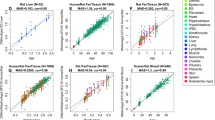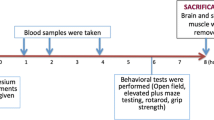Abstract
Purpose
Raloxifene undergoes extensive glucuronidation in the gastrointestinal (GI) tract and the liver. However, the impact of age on raloxifene disposition has never been studied. The purpose of this paper is to determine glucuronidation and Pharmacokinetics (PK) profiles of raloxifene in rats at different ages.
Methods
Raloxifene glucuronidation was characterized using S9 fractions prepared from different intestinal segments and the liver of F344 rats at 4-, 11-, and 28-week. PK studies were conducted to determine raloxifene oral bioavailability at different ages. Raloxifene and its glucuronides were quantified using LC-MS/MS.
Results
Raloxifene-6-glucuronide and raloxifene-4′-glucuronide were detected as the major metabolites and the ratio of these two glucuronides were different ranging from 2.1 to 4.9 folds in the ileum, jejunum, liver, and duodenum, and from 14.5 to 50 folds in the colon. The clearances in the duodenum at 4-week for both two glucuronides were significantly lower than those at the other two ages. PK studies showed that the oral bioavailability of raloxifene is age dependent. The absolute oral bioavailability of raloxifene was 3.5-folds higher at 4-week compared to that at 11-weeks. When raloxifene was administered through IV bolus, its half-life was 5.9 ± 1.16 h and 3.7 ± 0.68 h at 11-and 4-week, respectively.
Conclusion
These findings suggested that raloxifene metabolism in the duodenum was significantly slower at young age in rats, which increased the oral bioavailability of raloxifene. At 11-week, enterohepatic recycling efficiency was higher than that of 4-week. Raloxifene’s dose at different ages should be carefully considered.







Similar content being viewed by others
Data Availability
The datasets generated during and/or analyzed during the current study are available from the corresponding author on reasonable request.
References
Seeman E. Raloxifene. J Bone Miner Metab. 2001;19(2):65–75.
Ettinger B, Black DM, Mitlak BH, Knickerbocker RK, Nickelsen T, Genant HK, et al. Reduction of vertebral fracture risk in postmenopausal women with osteoporosis treated with raloxifene: results from a 3-year randomized clinical trial. Multiple outcomes of Raloxifene evaluation (MORE) investigators. JAMA. 1999;282(7):637–45.
Cranney A, Tugwell P, Zytaruk N, Robinson V, Weaver B, Adachi J, et al. The Osteoporosis research advisory G. Meta-analyses of therapies for postmenopausal osteoporosis. IV. Meta-analysis of raloxifene for the prevention and treatment of postmenopausal osteoporosis. Endocr Rev. 2002;23(4):524–8.
Jolly EE, Bjarnason NH, Neven P, Plouffe L Jr, Johnston CC Jr, Watts SD, et al. Prevention of osteoporosis and uterine effects in postmenopausal women taking raloxifene for 5 years. Menopause. 2003;10(4):337–44.
Barrett-Connor E, Mosca L, Collins P, Geiger MJ, Grady D, Kornitzer M, et al. Raloxifene use for the heart trial I. effects of raloxifene on cardiovascular events and breast cancer in postmenopausal women. N Engl J Med. 2006;355(2):125–37.
Weickert TW, Weinberg D, Lenroot R, Catts SV, Wells R, Vercammen A, et al. Adjunctive raloxifene treatment improves attention and memory in men and women with schizophrenia. Mol Psychiatry. 2015;20(6):685–94.
Kulkarni J, Gavrilidis E, Gwini SM, Worsley R, Grigg J, Warren A, et al. Effect of adjunctive Raloxifene therapy on severity of refractory schizophrenia in women: a randomized clinical trial. JAMA Psychiatry. 2016;73(9):947–54.
Ho TH, Nunez-Nateras R, Hou YX, Bryce AH, Northfelt DW, Dueck AC, et al. A study of combination Bicalutamide and Raloxifene for patients with castration-resistant prostate Cancer. Clin Genitourin Cancer. 2017;15(2):196–202 e191.
Lawrence SE, Faught KA, Vethamuthu J, Lawson ML. Beneficial effects of raloxifene and tamoxifen in the treatment of pubertal gynecomastia. J Pediatr. 2004;145(1):71–6.
Morello KC, Wurz GT, DeGregorio MW. Pharmacokinetics of selective estrogen receptor modulators. Clin Pharmacokinet. 2003;42(4):361–72.
Jeong EJ, Liu Y, Lin H, Hu M. Species- and disposition model-dependent metabolism of raloxifene in gut and liver: role of UGT1A10. Drug Metab Dispos. 2005;33(6):785–94.
Du T, Sun R, Li L, Ebuzoeme C, Bui D, Zheng Z, et al. Development and validation of ultra-high-performance liquid chromatography-mass spectrometry method for the determination of raloxifene and its phase II metabolites in plasma: application to pharmacokinetic studies in rats. J Sep Sci. 2020;43(24):4414–23.
Sun R, Zhu L, Li L, Song W, Gong X, Qi X, et al. Irinotecan-mediated diarrhea is mainly correlated with intestinal exposure to SN-38: critical role of gut Ugt. Toxicol Appl Pharmacol. 2020;398:115032.
Wu B, Basu S, Meng S, Wang X, Hu M. Regioselective sulfation and glucuronidation of phenolics: insights into the structural basis. Curr Drug Metab. 2011;12(9):900–16.
Lindstrom TD, Whitaker NG, Whitaker GW. Disposition and metabolism of a new benzothiophene antiestrogen in rats, dogs and monkeys. Xenobiotica. 1984;14(11):841–7.
Branca JJV, Gulisano M, Nicoletti C. Intestinal epithelial barrier functions in ageing. Ageing Res Rev. 2019;54:100938.
Bolling BW, Court MH, Blumberg JB, Chen CY. Microsomal quercetin glucuronidation in rat small intestine depends on age and segment. Drug Metab Dispos. 2011;39(8):1406–14.
Neumann E, Mehboob H, Ramirez J, Mirkov S, Zhang M, Liu W. Age-dependent hepatic UDP-glucuronosyltransferase gene expression and activity in children. Front Pharmacol. 2016;7:437.
Quinn R. Comparing rat's to human's age: how old is my rat in people years? Nutrition. 2005;21(6):775–7.
Sengupta P. The laboratory rat: relating its age with Human's. Int J Prev Med. 2013;4(6):624–30.
Kosaka K, Sakai N, Endo Y, Fukuhara Y, Tsuda-Tsukimoto M, Ohtsuka T, et al. Impact of intestinal glucuronidation on the pharmacokinetics of raloxifene. Drug Metab Dispos. 2011;39(9):1495–502.
Roberts MS, Magnusson BM, Burczynski FJ, Weiss M. Enterohepatic circulation: physiological, pharmacokinetic and clinical implications. Clin Pharmacokinet. 2002;41(10):751–90.
Kosaka K, Watanabe T, Susukida T, Aoki S, Sekine S, Kume T, et al. Key determinants of the circulatory exposure of organic anions: differences in hepatic uptake between multidrug resistance-associated protein 2 (Mrp2)-deficient rats and wild-type rats. Xenobiotica. 2015;45(6):556–62.
Yang G, Ge S, Singh R, Basu S, Shatzer K, Zen M, et al. Glucuronidation: driving factors and their impact on glucuronide disposition. Drug Metab Rev. 2017;49(2):105–38.
Li Y, Ning L, Yin Y, Wang R, Zhang Z, Hao L, et al. Age-related shifts in gut microbiota contribute to cognitive decline in aged rats. Aging (Albany NY). 2020;12(9):7801–17.
Johnson DR, Guo GL, Klaassen CD. Expression of rat multidrug resistance protein 2 (Mrp2) in male and female rats during normal and pregnenolone-16alpha-carbonitrile (PCN)-induced postnatal ontogeny. Toxicology. 2002;178(3):209–19.
Chad Douglas Moore GSY. Cytochrome P450 3A4 regiospecific oxygenation of raloxifene: Evidence for the formation of the di-quinone methide. FASEB J. 2008;22, issue S1 Experimental Biology 2008 meeting abstracts(S1):1131–5.
Zhou X, Wang S, Sun H, Wu B. Sulfonation of raloxifene in HEK293 cells overexpressing SULT1A3: involvement of breast cancer resistance protein (BCRP/ABCG2) and multidrug resistance-associated protein 4 (MRP4/ABCC4) in excretion of sulfate metabolites. Drug Metab Pharmacokinet. 2015;30(6):425–33.
Xu SF, Hu AL, Xie L, Liu JJ, Wu Q, Liu J. Age-associated changes of cytochrome P450 and related phase-2 gene/proteins in livers of rats. PeerJ. 2019;7:e7429.
Klaassen CD, Liu L, Dunn RT 2nd. Regulation of sulfotransferase mRNA expression in male and female rats of various ages. Chem Biol Interact. 1998;109(1–3):299–313.
Scott JA, Da Camara CC, Early JE. Raloxifene: a selective estrogen receptor modulator. Am Fam Physician. 1999;60(4):1131–9.
Funding
This work was supported by a grant from the National Institute of General Medical Sciences (1R15GM126475-01A1) and Cancer Prevention Research Institute of Texas (CPRIT, RP190672) for Song Gao. This work was also made possible, in part, by services provided from GCC Center for Comprehensive PK/PD and Formulation (CCPF) with CPRIT grant number of RP180748 and National Institute of Minority Health and Health Disparity (U54MD007605) for Dong Liang.
Author information
Authors and Affiliations
Corresponding authors
Additional information
Publisher’s Note
Springer Nature remains neutral with regard to jurisdictional claims in published maps and institutional affiliations.
Rights and permissions
About this article
Cite this article
Du, T., Sun, R., Etim, I. et al. Age-and Region-Dependent Disposition of Raloxifene in Rats. Pharm Res 38, 1357–1367 (2021). https://doi.org/10.1007/s11095-021-03084-y
Received:
Accepted:
Published:
Issue Date:
DOI: https://doi.org/10.1007/s11095-021-03084-y




